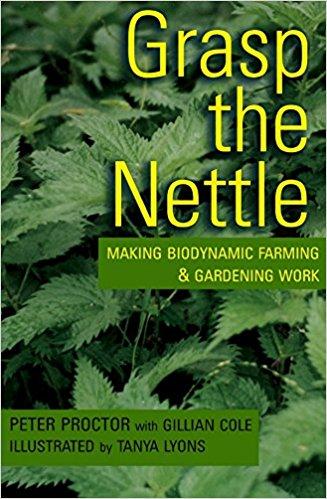by Rosemary Tayler
 Grasp the Nettle: Making Biodynamic Farming and Gardening Work by Peter Proctor with Gillian Cole is a Random House New Zealand book first published in 1997. The revised edition, put out in 2004, has had six reprints since then, testifying to its continued popularity and usefulness. This book's comprehensive instructions as well as its easy-to-read style enables the reader to feel confident and self-assured when undertaking any and all of the described biodynamic procedures. Grasp the Nettle: Making Biodynamic Farming and Gardening Work by Peter Proctor with Gillian Cole is a Random House New Zealand book first published in 1997. The revised edition, put out in 2004, has had six reprints since then, testifying to its continued popularity and usefulness. This book's comprehensive instructions as well as its easy-to-read style enables the reader to feel confident and self-assured when undertaking any and all of the described biodynamic procedures.
Chapter 1 presents the reader with a deeper understanding of the geometric configuration of the spiral and its expression in nature. Also, it explains what happens in a vortex. Chapter 2 is an alchemical introduction to the four elements as reflected in the basic components of plants. Proctor clearly captures the essence of these forms and their correlations with the various ethers. Chapter 3 offers a description of the basic principles of soil science and explains how biodynamic preparations affect soil quality. Chapter 4 goes into detail on how to make and use Horn Manure (BD500) while Chapter 5 elaborates on how to make Horn Silica (BD501).
Chapter 6 begins with a practical step-by-step procedure for making compost and ends with a similar description on how to make Barrel Compost, also called Cowpat Pit (CPP). Again the details are stellar. Chapter 7 presents a brief introduction on how to make the compost preparations as well as fermented horsetail (BD508).
From there Proctor discusses the pratical steps one can take when converting from a conventional to a biodynamic farm, orchard or vineyard. He goes on to elaborate on how to establish a commercial and/or a home vegetable operation. Details include such topics as soil fertility management, crop rotation compost application and use of the various biodynamic preparations.
In Chapter 11, Proctor delves into Rudolf Steiner's understanding on the contribution calcium and silica make to the soil environemnt and how to enhance these mineral energies can be balanced on a biodynamic farm. Chapter 12 focuses on the value of practical observation by way of using one's senses of smell, taste, touch and sight. Chapter 13 offers a range of stories about biodynamic farmers working on a dairy farm, in a mixed crop setting, in an orchard and on a market garden farm.
Chapter 14 takes the reader back in time to the early days of making biodynamic preparations at universities and colleges in India. Included are research results on soya bean trials. Chapter 15 looks at the status of biodynamic agriculture in several European countries as well as a brief overview of what has occurred in North and South America and Australia.
While these last two chapters are somewhat dated, it is nevertheless clear that the overall intention Proctor held was that this book would convince the reader on the need to convert conventional farms not only to an organic system but also to one that incorporates a biodynamic protocol. His practical advice and comprehensive instructions make such a transition very doable.
While the passing of Peter Proctor in June of 2018 has left a gap in the biodynamic circle, his wisdom and practical knowledge live on through this book.
|


![]()

 Grasp the Nettle: Making Biodynamic Farming and Gardening Work by Peter Proctor with Gillian Cole is a Random House New Zealand book first published in 1997. The revised edition, put out in 2004, has had six reprints since then, testifying to its continued popularity and usefulness. This book's comprehensive instructions as well as its easy-to-read style enables the reader to feel confident and self-assured when undertaking any and all of the described biodynamic procedures.
Grasp the Nettle: Making Biodynamic Farming and Gardening Work by Peter Proctor with Gillian Cole is a Random House New Zealand book first published in 1997. The revised edition, put out in 2004, has had six reprints since then, testifying to its continued popularity and usefulness. This book's comprehensive instructions as well as its easy-to-read style enables the reader to feel confident and self-assured when undertaking any and all of the described biodynamic procedures.